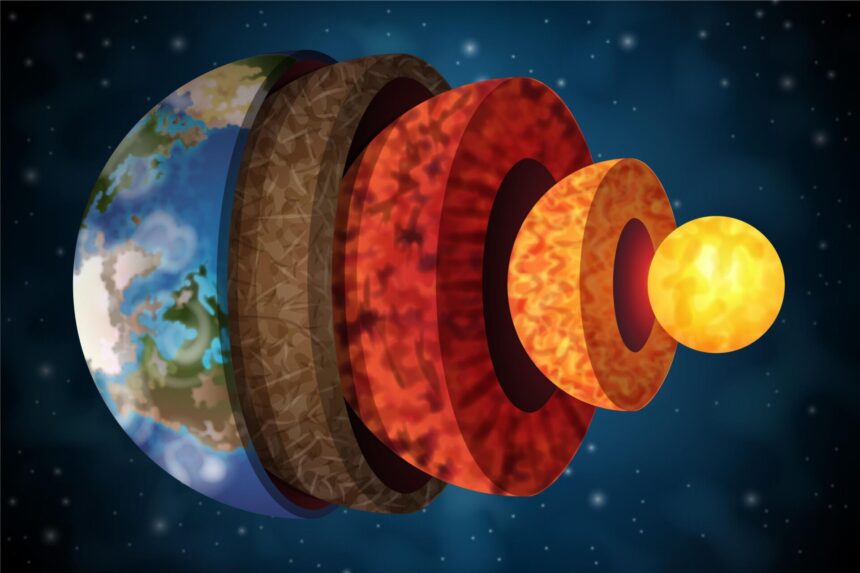Introduction:
Earth’s interior – a fiery underworld hidden beneath the familiar landscapes we tread upon. Imagine a realm of crushing pressure, molten rock that flows like rivers, and a heart of iron hotter than the sun’s surface. This hidden world isn’t science fiction; it’s our planet’s foundation.
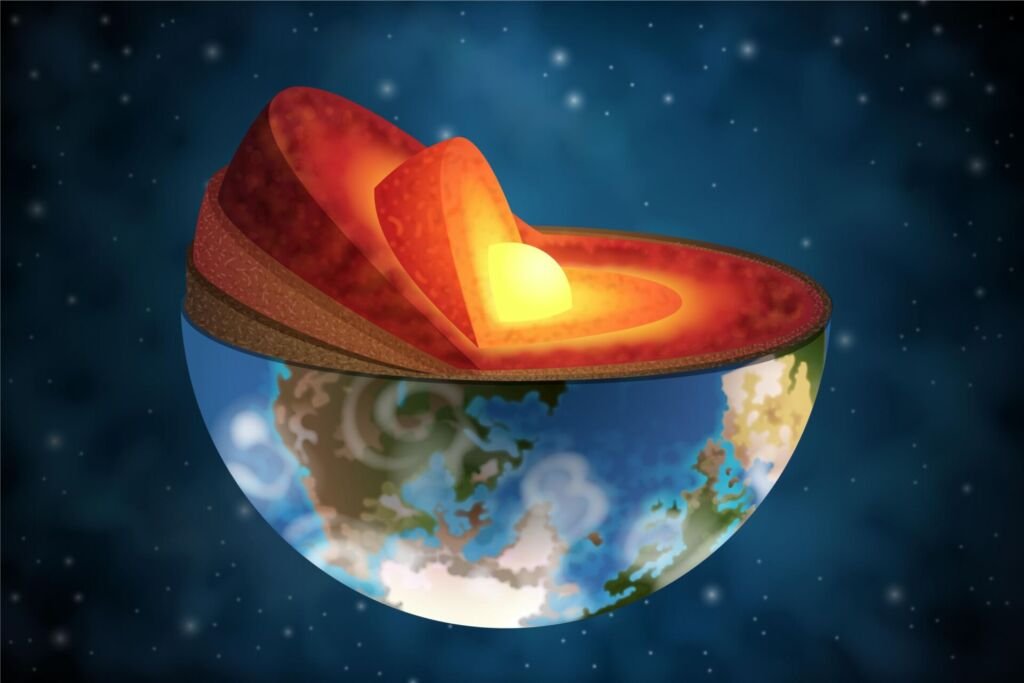
For centuries, the secrets of the Earth’s interior have sparked our curiosity. Ancient myths whispered of underworld journeys, while modern science paints a picture of dynamic forces in constant motion. Geologists act like planetary detectives, piecing together clues from earthquakes, ancient rocks, and even the remnants of fallen meteorites.
This journey below the surface is more than just satisfying our curiosity. Our planet’s interior holds the keys to understanding earthquakes, volcanic eruptions, and even the rise and fall of continents. So, prepare to embark on a voyage into the very core of our world!
The Earth's Structure: A Layered Journey
Our planet isn’t just a solid sphere. Picture the Earth’s interior as a complex series of layers, each with unique properties and playing a vital role in shaping our world. Let’s delve into these layers, starting from the surface and venturing towards the fiery center:
The Crust: Fragile Outer Shell
- The Earth’s crust is the outermost layer, a thin but vital shell that holds all the familiar landscapes we see – continents, mountains, and ocean floors. While it might seem substantial, the crust makes up a tiny fraction of Earth’s total volume, less than 1%.
Oceanic Crust vs. Continental Crust
There are two main parts of the crust reflecting the underlying geological differences:
Oceanic Crust:
- Much thinner, averaging 5 to 10 kilometers (3 to 6 miles) thick.
- Made up of denser, heavier rocks like basalt (mafic rocks).
- Forms the seafloor beneath the deep oceans.
Continental Crust:
- Thicker, ranging from 30 to 50 kilometers (20 to 30 miles) on average.
- Composed primarily of less dense, lighter rocks like granite (felsic rocks).
- Covers the continents and extends under shallow ocean areas near coastlines.
There is a certain region in the interior where the velocity of the seismic waves changes suddenly between the crust and the mantle. This zone of separation is named after the Yugoslav seismologist Mohorovocic, Mohorovicic discontinuity, also called Moho discontinuity or M. discontinuity.
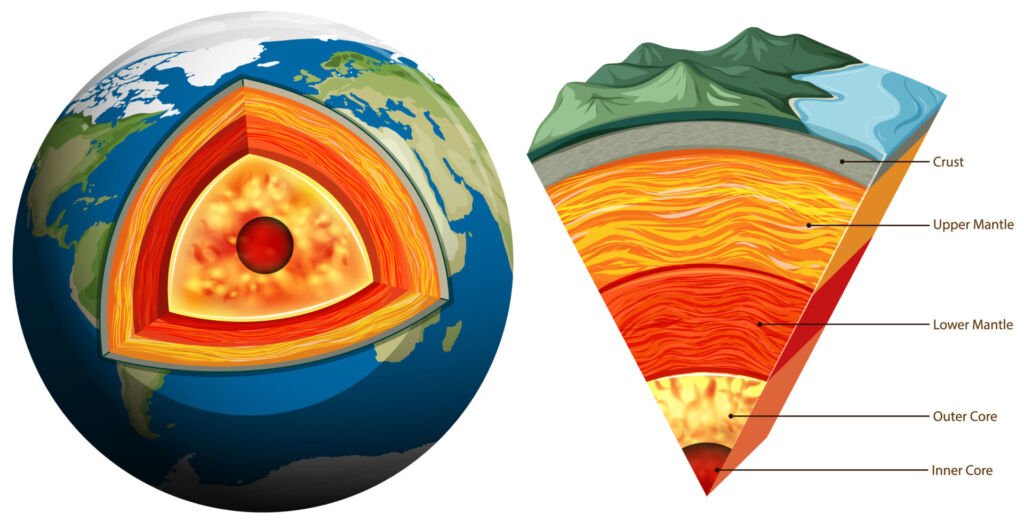
The Mantle: A Vast Zone of Convection
- Earth’s thickest layer (about 2900 km thick) makes up most of the Earth’s interior.
- Unlike the brittle crust, the mantle is mostly solid rock, but with a twist – on geologic timescales, it behaves like a slow-flowing, viscous fluid.
- The mantle primarily comprises silicate rock, a mix of silicon, oxygen, and other elements. However, unlike the crust, it likely contains more iron and magnesium, making it denser.
The Upper Mantle and the Lithosphere
- The topmost part of the mantle extends from the base of the crust to a depth of about 660 kilometers (410 miles). It’s relatively cooler and more rigid than the lower mantle. The crust’s upper mantle and lower portion form a rigid shell called the lithosphere, broken into tectonic plates that move across the asthenosphere.
The Asthenosphere: Where Continents Drift
- This lower region of the mantle, located between 660 and 2,900 kilometers (410 and 1,800 miles) deep, is hotter and more plastic. The intense heat and pressure make the rock in the asthenosphere partially molten, allowing it to flow slowly, causing the movement of tectonic plates above.

- Mantle Plumes: Hot, upwelling plumes of rock rising from deep within the mantle can create volcanic hotspots like Hawaii. Understanding these plumes is crucial for predicting volcanic activity.
There is a certain region in the interior where the velocity of the seismic waves (P-waves) suddenly reduces, and S-waves disappear between the mantle and the core. This zone of separation is called the Gutenberg discontinuity.
The Core: Earth's Fiery Heart
This is the Earth’s core, the hottest and densest part of our planet, accounting for about 15% of its total volume. Unlike the crust and mantle, the core is entirely metallic, a molten and solid duo that generates the Earth’s magnetic field and plays a crucial role in its internal dynamics.
Mostly made of iron and nickel. Its intense temperatures and pressure are staggering.
The Outer Core: A Liquid Metal Dynamo
- This hot, swirling layer extends from the base of the mantle (2,890 km or 1,800 miles deep) to about 5,150 km (3,200 miles). It’s composed primarily of molten iron and nickel, with a temperature ranging from 4,400 °C (8,132 °F) near the outer boundary to a scorching 6,100 °C (9,932 °F) closer to the inner core. The intense heat and pressure keep this metal alloy in a liquid state, allowing it to flow freely and generate the Earth’s magnetic field through the dynamo effect.
- Liquid iron churns, generating Earth’s magnetic field –vital for shielding us from space radiation.
The Inner Core: Pressure and Solid Iron
- This innermost ball of our planet, starting at 5,150 km (3,200 miles) deep and extending to the Earth’s center (around 6,370 km or 3,958 miles deep), is surprisingly solid. Despite the enormous heat (estimated at 5,200 °C or 9,392 °F), the immense pressure, reaching millions of times greater than atmospheric pressure, keeps the iron and nickel alloy in a solid state.
- Despite temperatures rivaling the sun’s surface, the immense pressure forces the inner core into a solid iron ball.
How Do We Know About the Earth's Interior?
Directly exploring the Earth’s interior poses an impossible challenge: the deeper you go, the hotter and more extreme the conditions become. So, how do we uncover the secrets of this hidden world? Here are the invaluable tools scientists use to decipher the nature of the Earth’s interior:
Seismic Waves: Earth's Internal X-ray
- P-Waves and S-Waves: Earthquakes generate powerful vibrations called seismic waves. P-waves (primary waves) travel fastest, compressing and expanding the material they pass through. S-waves (secondary waves) move with a shearing motion. Crucially, S-waves cannot travel through liquids.
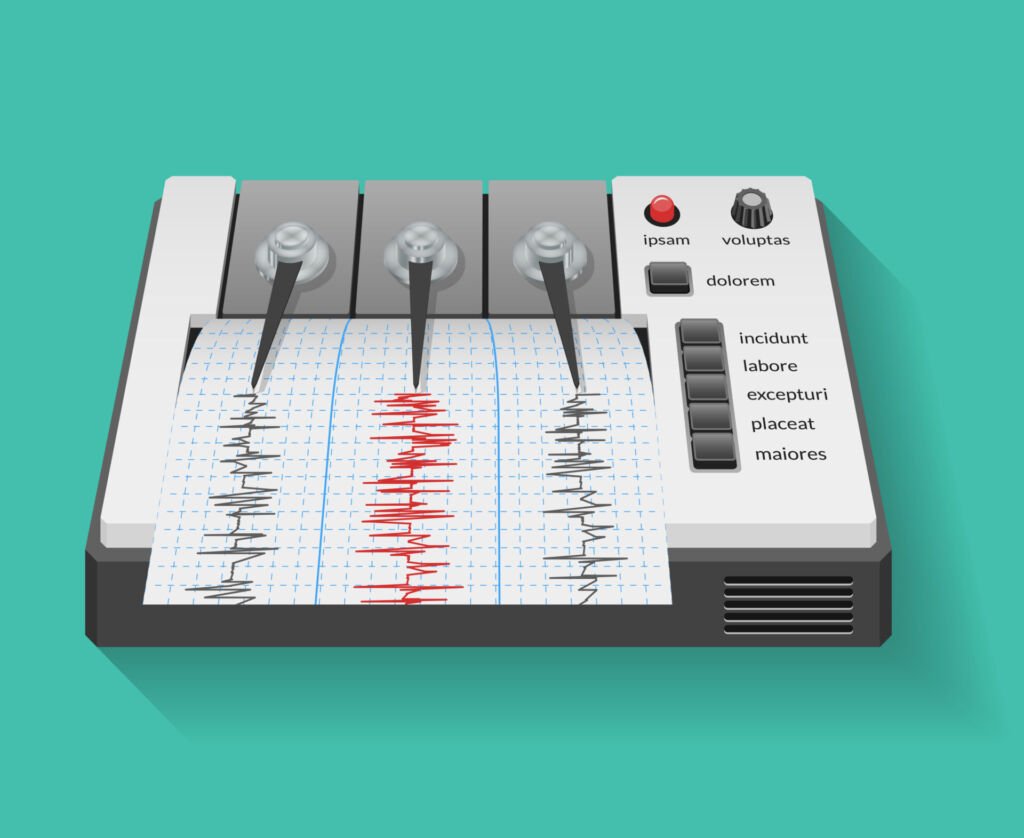
- Seismic Reflections and Refractions: As seismic waves encounter boundaries between different layers within the Earth’s interior, they are reflected and refracted (bent). By analyzing the patterns of these waves, scientists can map the boundaries deep within the planet.
Other Clues to the Earth's Depths
- Rock Samples from Volcanoes: Volcanic eruptions occasionally blast rock fragments from deep within the mantle to the surface. These provide direct samples to analyze, giving insights into the composition of the Earth’s interior.
- Meteorites and the Earth’s Composition: Some meteorites are considered fragments of ancient planetesimals, bodies from which planets formed. Their composition sheds light on the likely building blocks of the Earth’s interior, hinting at a mostly iron-nickel core.
The combined use of these tools paints a detailed picture of our planet’s inner depths. It’s a testament to the ingenuity of science that we can understand the very core of our Earth, even though it remains forever beyond our direct reach.
The Dynamic Earth: Plate Tectonics and the Earth's Interior
Far from being a static, unchanging sphere, the Earth’s interior is a constant movement and transformation realm. The engine driving this dynamism lies deep within the mantle, where powerful forces give rise to the incredible phenomena we witness on the surface.
Convection in the Mantle: The Engine of Change
- Picture the mantle as a vast, swirling ocean of semi-molten rock heated from below by the intense heat of the Earth’s core. This heat creates convection currents: hotter, less dense material rises while cooler, denser material sinks.
- Imagine these convection currents like massive conveyor belts, slowly but surely dragging sections of the Earth’s crust (and upper mantle), called tectonic plates, along with them.
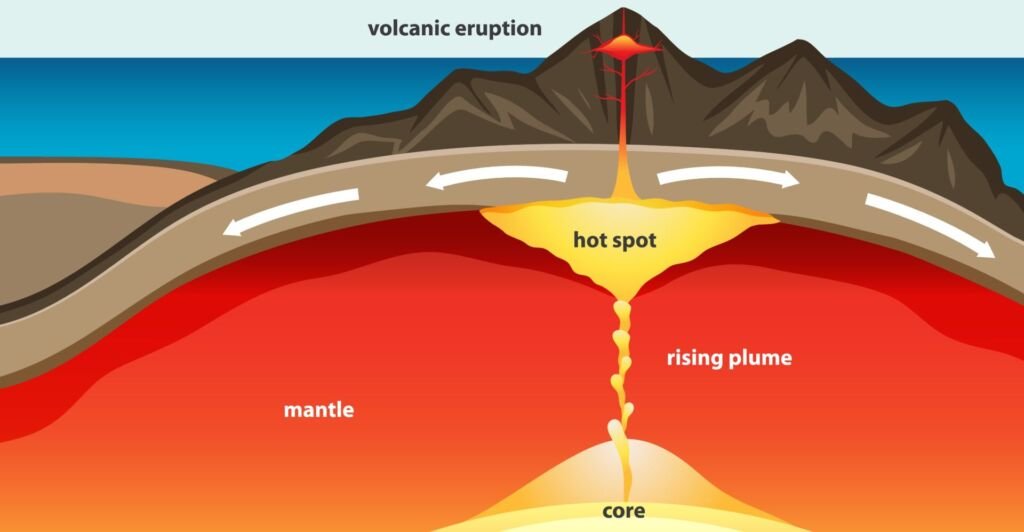
Plumes, Hotspots, and Mantle Dynamics
- The Earth’s interior isn’t uniform. Within the mantle, plumes – columns of superheated material rise from near the boundary with the core.
- Where these plumes reach the surface, they create “hotspots” – often marked by intense volcanic activity. Famous examples include the Hawaiian Islands and Yellowstone National Park.
- These plumes add another layer of complexity to the dynamics within the Earth’s interior, influencing how plates move and interact.
The Role of the Earth's Interior in Shaping the Surface
- Plate tectonics, fueled by the Earth’s interior forces, is the grand architect of our planet’s surface:
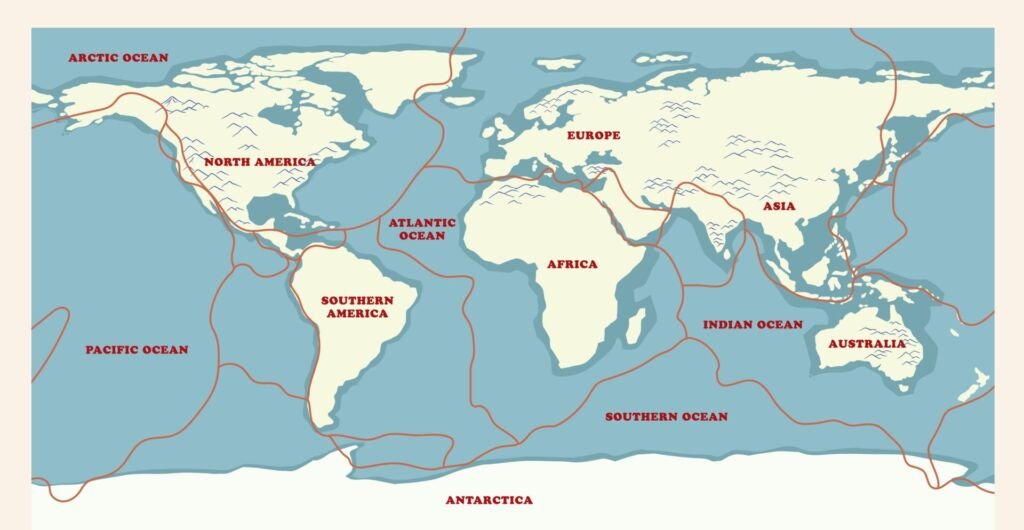
- Where plates collide, mighty mountain ranges are thrust upwards (think the Himalayas).
- Where plates pull apart, deep valleys form, and new oceanic crust is born (like the Mid-Atlantic Ridge).
- Volcanoes, particularly those along plate boundaries, release gases from the Earth’s interior, contributing to our atmosphere.
- Earthquakes shake the world as pent-up energy is unleashed within the Earth’s interior.
The churning mantle and the movement of tectonic plates are constant reminders of our planet’s vibrant core. The landscapes are just the results of the actions of the remarkable forces within the Earth’s interior.

Mysteries and Frontiers: What We Still Don't Know About the Earth's Interior
Even as science pushes further into the depths, our view of the Earth’s interior still needs to be completed. Here are some of the most persistent mysteries and exciting frontiers of exploration:
The Inner Core's Complexity
The Earth’s inner core, a solid iron ball, should be simple. However, recent research reveals surprising complexities:
- It might not be uniform: Seismic studies suggest that the eastern and western halves of the inner core have different crystalline structures, implying a complex formation history.
- Superrotation: Some evidence suggests that the inner core rotates slightly faster than the rest of the Earth, though this remains debatable.
The D" Layer: A Boundary Zone Enigma
The D” layer is a strange region at the very base of the mantle, where it meets the outer core. This zone has a reputation for bizarre behavior:
- Ultra-Low Velocity Zones: Pockets within the D” layer slow down seismic waves dramatically, hinting at partially molten areas or exotic mineral compositions.
- Birthplace of Mantle Plumes? Enormous hot rock plumes that rise to the surface causing volcanic hotspots like Hawaii, may originate within the D” layer.
Mapping the Mantle in Greater Detail
The Earth’s mantle is vast, making it challenging to image with precision. Yet, finer details of mantle structure are essential for building more accurate models of our planet:
- Lost Slabs: Subducted tectonic plates sink into the mantle. Seismology is improving at tracking these ‘slab graveyards, helping piece together Earth’s history.
- Mantle Chemical Diversity: The mantle isn’t uniform in composition. Mapping variations could show how Earth’s interior evolved over billions of years.
These mysteries of the Earth’s interior fuel ongoing research. With advanced seismic networks, lab experiments replicating deep Earth conditions, and ever-improving computer simulations, the secrets of our planet’s fiery heart are slowly being revealed.
Conclusion
Our journey into the Earth’s interior reveals a realm as dynamic as it is mysterious. Despite centuries of exploration, we’ve only scratched the surface of understanding its hidden depths. The crust, mantle, and core are not merely layers but interconnected systems that have sculpted our planet from its fiery birth to the present day.
While the Earth’s interior might seem inaccessible, every earthquake, volcanic eruption, and even the shifting continents whisper its secrets. Each discovery rewrites our understanding of plate tectonics, the magnetic field, and the very origins of life.
The ongoing research into the Earth’s depths is about more than just about scientific knowledge. Understanding how the interior interacts with the surface is crucial for predicting natural hazards and managing our planet’s resources. Our world continues to shape itself from deep within – a potent reminder of the incredible forces beneath our feet.

